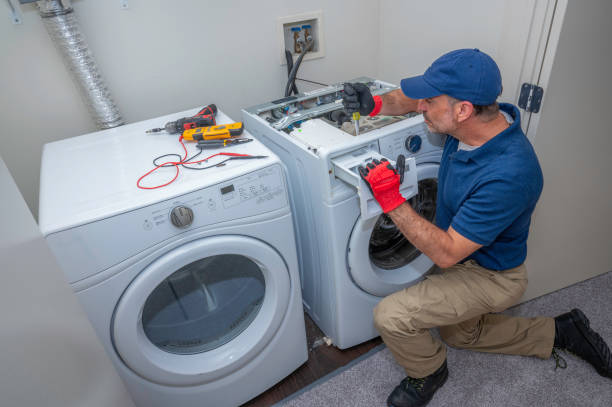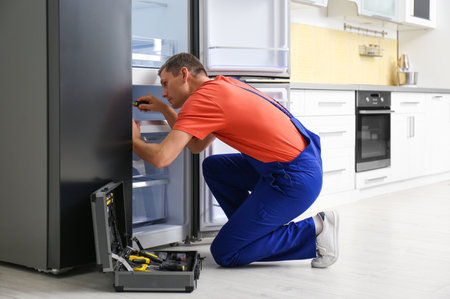Fascination About Oven Repair Specialist
Fascination About Oven Repair Specialist
Blog Article

Stove Repair Work: Fixing Heating and Electrical Issues
Recognizing Your Device: Fundamental Oven Framework
The normal oven style includes a couple of key architectural components that preserve its performance. These are the stove cavity, thermostat, heating element, shelfs, and control panel. The oven tooth cavity is the central cooking compartment, designed to prolong warm evenly, along with thermo-insulating residential properties. The thermostat component regularly controls warmth temperature level, providing an ideal food preparation setting. The heating element is the primary resource of warm-- maybe electric or gas. Shelfs provide support for the baking trays, whereas the control panel consists of all user-operated controls.
Understanding these essential elements and their roles is the initial step in the direction of comprehending exactly how an oven operates. For example, when an oven is switched on, electric or gas power is transformed to thermal energy by the heating element under the control of the thermostat. The warmth created is then evenly distributed within the stove tooth cavity. This basic understanding enables users to recognize usual issues such as irregular baking or temperature change, further equipping them to carry out quick and efficient troubleshooting.
Recognizing Typical Heating Concerns in Ovens
Typical home heating problems in stoves commonly make themselves known via a variety of clear indicators. These may consist of fluctuating temperature levels, where the oven stops working to maintain a steady warm, or unequal cooking, where food cooks quicker on one side than the other. Another clear symptom is when the oven takes longer than anticipated to reach the collection temperature or it simply reaches a temperature level much less than desired. Preheating ought to generally take no more than about 15 mins depending on your device. If it takes considerably longer, a home heating issue may be at hand.
Stoves can likewise present a consistent mistake code on the oven display screen, indicating an interior issue which could be related to the heating mechanisms. They might additionally stop working to warm in any way, a guaranteed sign of a home heating issue. Some ovens might even get too hot, obtaining much hotter than the chosen temperature and melting the food. In worse situations, they might possibly be a fire threat. It is important to remain watchful of these common indicators to determine and correct home heating problems at an early stage.
Reliable Techniques to Troubleshoot Oven Heating Problems
Having actually determined the possible problems influencing your oven's home heating ability, it's important to apply efficient troubleshooting strategies to mitigate these problems. The initial step includes initial checks. See to it the power source is attached optimally which the stove's thermostat is established correctly. Making certain these essential elements are in order can usually fix small issues without further extensive assessment.
On the other hand, if troubles linger after the first checks, dive much deeper into possible hardware malfunctions that could be the root of the home heating concern. Beginning with examining the heating element. In circumstances where it shows up harmed or malfunctioning-- identified by noticeable fractures, blisters, or it seems stressed out, it is very probable this could be the source of the problem. One more crucial element to check is the oven sensor. Bulk of stoves include a sensor that plays an important function in maintaining the needed temperature level variety. Thus, a malfunctioning sensing unit can substantially influence the oven's home heating efficiency. In order to assess the sensing unit's performance, you may need a multimeter-- an innovative device used to determine electrical buildings such as resistance and voltage. It is suggested that these actions must be executed meticulously thinking about the inherent dangers associated with electrical home appliances.
Following this, if the stove still falls short to heat up properly, think about checking for a malfunctioning bake or broil component. These elements are accountable for providing the warm required to cook your food and could be contributing variables if they're defective. Finally, inspect other elements such as the control panel and electrical wiring connections which can also impact heating performance.
To summarize, below are effective techniques that can help you fix home heating issues in a stove:
Carry out initial checks: Ensure that the power source is linked appropriately and check if the thermostat setup is accurate.
Check hardware breakdowns: If initial checks don't fix the concern, explore possible equipment issues. Begin by taking a look at crucial elements like:
The Heating Element: Look for visible cracks, blisters or indicators of exhaustion.
The Stove Sensing Unit: Make use of a multimeter to determine its electrical buildings and determine whether it's operating properly.
Explore other potential concerns: If all else stops working,
Evaluate Bake or Broil Elements: These components supply essential food preparation heat; their malfunctioning might result in inadequate home heating.
Evaluation Control Board & Wiring Links: Faulty links or a troublesome control board may also be at fault.
Bear in mind always work out care while managing electric appliances as a result of intrinsic threats entailed. It's suggested that only individuals knowledgeable about dealing with such tools should try these troubleshooting actions individually. In case of persistent issues in spite of adhering to these techniques, looking for expert aid would be suggested.
Exploring Electric Problems in Stoves
Understanding the electric functioning of your stove is vital in detecting possible issues that may arise. Frequently, these difficulties surface in the form of a stove that doesn't heat properly, intermittent power or in extreme cases, complete failure of the device. These concerns might be set off by many variables ranging from faulty wires to malfunctioning burner or problematic control buttons.
Circuit-related troubles are frequently found within the detailed web of cables and links ensconced within the stove's structure. These mistakes can commonly cause short-circuiting or underperformance because of inconsistent power flow. Additionally, failing to identify and correct these electrical problems can not just reduce a home appliance's functional efficiency, but also present potential fire threats and electric shock threats. For that reason, comprehending these complications and utilizing the correct measures to address them is critical.
Practical Tips to Identify Electric Issues with Ovens
Detecting electrical problems with stoves normally begins with a detailed aesthetic evaluation. First and foremost, constantly guarantee to unplug the stove before starting any investigation to get rid of the threat of electrical shock. After doing so, check the power cable for any noticeable indicators of wear, tear, or burning. Then, proceed to examine the terminal block situated at the back of your stove-- it might be possible that the problem occurs from a loose or scorched cable. This key analysis can give beneficial understandings right into whether the problem is associated with the source of power or internal digital parts of the stove.
In case you discovered no concern throughout your aesthetic assessment, your next point to concentrate on should be the oven's internal elements. Use a multimeter to check the heating elements' continuity, as faulty elements can be a typical root cause of electric issues. If the multimeter analysis stays the same, this indicates a lack of electrical circulation and the element in question might require substitute. Likewise, the oven thermostat, a variable resistance switch regulating the warm, ought to likewise be evaluated for electrical connection. If these examinations don't produce results, consider checking the stove's timer and selector switch, noting that these parts require even more technical knowledge to evaluate accurately.
Safety And Security Preventative Measures to Think About during Do It Yourself Troubleshooting
Participating in DIY troubleshooting of your stove can possibly save you a considerable quantity of expenditure on repairs, yet doing it without due diligence can posture a considerable risk to individual security. It's crucial to recognize that Fix Broken Oven engaging with home appliances, specifically those reliant on gas or electrical power like stoves, requires a particular degree of caution and preparation. Constantly make sure to switch off and unplug the home appliance before starting any kind of probing or disassembly. To stay clear of an electrocution hazard, never perform repair services with damp hands or stand on a wet floor.
In addition, constantly use the proper devices for any maintenance jobs and never attempt to require parts apart or with each other. This not just prevents unexpected damages to the appliance however additionally mitigates the threat of personal injury. Protective wear, such as rubber handwear covers and shatterproof glass, can provide an additional protect against unexpected injury. Most of all, if you're uncertain or uneasy with any kind of steps in the procedure, it is prudent to step back and employ professional help.
Devices Essential for Stove Fixing and Upkeep
Undertaking the job of oven repair work and upkeep demands the work of the ideal devices. Having the right tools not just ensures an efficient and timely repair work process however additionally substantially minimizes the opportunity of added damages as a result of inappropriate handling. Several of the crucial devices consist of a multimeter, which is made use of to determine the voltage, resistance, and other crucial electrical values in the stove. This aids in determining accurate electrical mistakes. A collection of screwdrivers, socket sets, and wrenches are additionally essential for the dismantling and rebuilding of the stove.
In addition to these basic devices, a pair of needle-nose pliers proves to be indispensable for dealing with small items or reaching tight areas within the oven framework. A wire pole dancer can additionally be available in convenient when taking care of oven's electric systems. A warm weapon, for example, is required for tasks such as loosening up rigid cords or shrinking the tubes around wiring connections. Additionally, buying high-grade protected handwear covers is of paramount value to guarantee security throughout work, as it supplies protection against possible shocks or burns. These devices form the crucial toolkit for somebody seeking to perform oven repair services and upkeep themselves. However, one ought to additionally bear in mind that facility or dangerous issues must be left in the hands of a specialist.
Professional Assistance: When to Employ a Specialist
Stove issues that are beyond fundamental troubleshooting might require a specialist's treatment. When you find that the appliance often journeys your breaker, does not warmth equally or simply stops working to come on, it might indicate an extra severe issue. Such detailed worries may entail hands-on repair service of crucial parts, rewiring of interior systems or taking care of possible gas leaks-- tasks that should not be taken lightly as a result of their prospective to create injury or home damages.
Working with a professional is not merely concerning settling the immediate problem. It's additionally about making certain the long life of your device and the safety of your home. Professionals are knowledgeable in interactively detecting and repairing devices, led by their extensive training and experience with a variety of stove models and brands. They can typically supply beneficial guidance on maintenance and preventive measures, based on their understanding of the system's background and problem. Relying on these tasks to a professional can prevent future failures, saving you time, money, and potentially guarding your home from major incidents caused by incorrect or incomplete fixings.